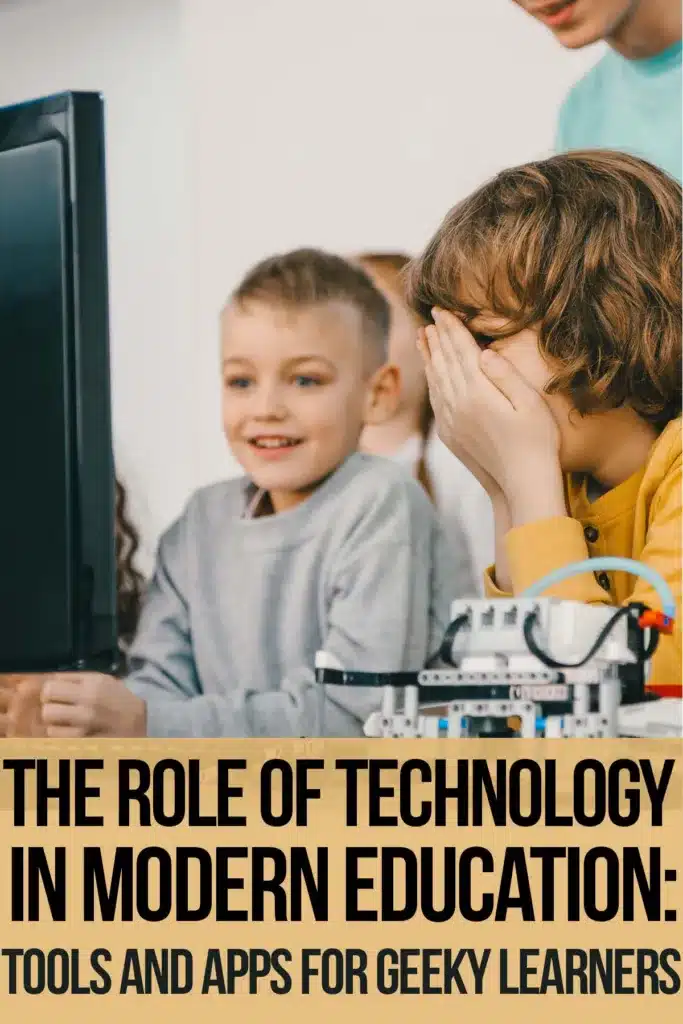Education in the simplest form is the sharing of knowledge. Whether it’s a son learning kayaking or boating from his father or a student understanding robotics from a lecturer, it is all a form of education. With time, we have integrated modern approaches into education. In this digital age, technological advancements are transforming the world. This is why using technology for education is the key to making the learning process smoother.

it is important to explore technology’s role in education. We also need to know about the best apps and tools and how can technology improve education.
Digital technology gained momentum in educational institutions during the early 2010s. Projectors and computers entered classrooms, while university admissions shifted online. And then the real big shift happened. When the pandemic struck in 2020, the education system turned to digital technology. Technology improved education and it made sure that the education process remained uninterrupted.
Benefits of apps and tools – digital learning methods
One of the greatest ways technology reduces the burden on students is by helping them do their writing work. Whether it’s crafting essays by themselves or getting them done through online professional writers, tech has made it possible. Students can access an essay maker as and when they want. To generate an essay, they simply need to visit EduBirdie. They have to follow simple steps. They get the perfect essay in quick time. What’s even better is that they can order an essay if they think they need a human writer to do their work.
If they prefer human writers over some tool or AI assistant, they can choose one on the site. This will improve academic success even more. This is because teachers value human writing more than auto-generated essays and other academic papers. This is because technology as a learning tool is useful but it can bring negative results when you use it where you don’t need to.
Using apps and tools in education boosts learning efficiency. Let’s go deeper and see how technology helps students learn.

1. Enhanced resource accessibility
Digital learning offers easy access to study materials, research papers, and textbooks. Global connectivity makes international resources available for reference. Learning becomes 24/7, accessible anytime and anywhere.
2. Performance analysis
Advanced technology helps in tracking progress. For example, if a student’s test scores drop, digital tools identify weaknesses. They recommend strategies for improvement. Applications help students understand their learning patterns and refine their performance.
3. Improved communication
Technological expansion enhances connectivity, even in education. Students can communicate, share experiences, and engage in discussions through various mediums.
4. Personalized learning
With the open availability of online resources, students can learn at their pace. They can do so without worrying about classroom dynamics. This freedom develops confidence and creativity. This has a direct positive impact on diverse learning approaches.
Digital technology opens new avenues for students and teachers. It makes learning better in many ways.
The best tools and apps for learners
1. Animated videos to make lessons easier
Watching videos makes complex ideas easy to understand. For example, videos show how we can carry out space missions and think of colonizing Mars one day. This makes learning science fun for kids. Even college students can learn complex topics. It could be anything from coding to algebra. With animated videos, teachers can add an element of enjoyment to learning.
2. Learning new languages with apps
Apps designed for learning languages are a big help. You can listen to words and practice speaking them yourself. This kind of practice makes learning languages like a game. This method of learning with apps makes it both enjoyable and effective in a fun way.
3. Sharing tools for assignments and submitting work
Sharing apps are handy for sharing academic work and handing in assignments. Teachers can quickly check what work you did and give feedback. It’s a quick way to manage classwork and even grading your essays and other assignments. This saves time for both students and teachers.
4. Great presentations with AI tools
Teachers often use slides with pictures and videos to teach. Nowadays, there are AI-based tools that help create great PPTs. This makes lessons more interesting and easy to follow. These slides also serve as notes for studying later. This helps students remember what they learned during the lecture.
5. Online classes and recorded videos
Right after the 2020 pandemic, classes moved online. Video calls and recorded videos made it possible to continue learning from home. With videos, if you miss something in class, you can go back and watch the video again to catch up on what you missed.
6. Creativity-boosting apps
Digital tech lets you learn in exciting ways. You can solve problems, share your ideas, and create mind maps to boost your creative side. This kind of learning is much more engaging than regular classroom teaching. It helps you use technology to solve real-world issues through creative ideas.
7. Learning with virtual reality
Virtual reality takes learning to a whole new level. It feels like you’re really there! You can explore different places and experiences without leaving your seat. Imagine it like a video game that helps you learn important things.
8. Learning through gaming
Game-based learning in education has really picked up in the last couple of years. There are apps that teach you while you play. These games make learning enjoyable and interactive, making it easier to remember what you learn. These help in creating engaging and immersive learning sessions.
There are also other ways to learn using tech. Some of these include making schedules, grading online, and chatting about lessons. Social media is also beneficial for educational purposes, like sharing events, creating forums and student study groups.
Besides these methods, there are many other approaches:
- Creating assignment calendars
- Online grading
- Virtual discussions
- Leveraging social media for educational events
These further enhance learning outcomes. Technology also enables collaboration among students from different institutions. They promote interactions with lecturers and enable the hosting of national to global-level competitions. This is how is technology used in education in various ways. The great news here is that the number of institutes using these apps and tools to enhance learning is consistently on the rise.

Conclusion
Technology has transformed education in remarkable ways. Just as rockets followed planes, applying technological advancements to education is essential. Digital learning (e-learning) has democratized education, making it accessible and user-friendly. Adopting digital technology enhances learning across age groups and subjects. This leads to better educational achievements.
Author’s Bio
Scott Roberts is an experienced writer who is always busy with some essay or dissertation for students. He sees his state of busyness as a learning experience. He believes that consistency brings rich dividends in the form of experience. It’s his ideas and this dedication to work that has won him awards in writing. This has made him a name that is reliable and trustworthy.
